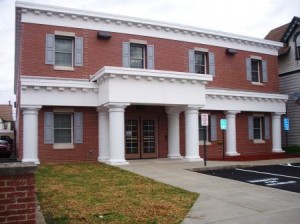
CLEARFIELD – The Clearfield County Commissioners heard from Mark Stephens, a hydrologist with the state’s Department of Environmental Protection, who spoke about source water protection at Tuesday’s workshop meeting.
On Aug. 23, the commissioners endorsed the Clearfield County Conservation District’s Growing Greener Grant application to implement a source water monitoring program and to install a combination of continuous data sondes and conductivity loggers on surface water sources, springs and groundwater wells.
In 1994, the Environmental Protection Agency began establishing a proactive strategy to protect water systems. And then, three years ago, Clearfield County Planning and Community Development and the CCCD were approached about the state’s Source Water Protection Technical Assistance Program (SWPTAP), Stephens said.
According to him, the local SWP programs are community-based voluntary efforts to protect drinking water sources used by community water systems. He said local programs are “effective tools” for public health protection and water supply security as well as a method to manage operational and capital costs through improved or maintained source water quality.
Stephens said SWPTAP can help develop and establish local SWP programs, and DEP has secured contractor services to provide technical expertise and assistance to interested community water systems. He said SWP programs can involve wellhead protection for groundwater sources, watershed protection for surface water sources or both for systems utilizing both groundwater and surface water.
Community water systems receiving services through SWPTAP are required to establish local SWP programs through a steering committee. The committee will develop a source water protection plan, detailing a program that meets DEP’s minimum elements, which include:
- a local steering community and public participation;
- a source water protection area delineation;
- a contaminant source inventory;
- source water protection area management methods and commitment;
- contingency planning; and
- the protection of identified new source sites.
Stephens said the SWP plan should include a strategy addressing both existing sources of contamination and potential of future contamination identified in a Source Water Assessment. Applicants eligible for SWPTAP include a community water system, an individual municipality with a community water system or a group of adjacent municipalities.
The DEP Source Water Protection staff in conjunction with its contractor will assist the community water system in developing a scope of work. The DEP will consider the following criteria when developing and reviewing proposals:
- How well does the project adhere to DEP’s minimum requirements for a SWP plan?
- What is the likelihood of successful completion within the projected timeframe?
- Does the project have a clear source water protection focus?
- Does the water supplier and or local government(s) demonstrate a commitment to develop, implement, support and sustain a local SWP program after funding is received?
- Will all of the components of a local SWP program be in place at completion?
According to Stephens, a SWPTAP project cannot extend more than two years. Eligible projects include: rigorous wellhead protection area delineation; enhanced contaminant source inventories; and SWP area management or planning (ordinance development, transfer of development rights, early warning monitoring systems, public education activities, road signs and emergency response plan enhancements/contingency planning).
Construction, including buildings, building materials and fencing isn’t an eligible category for SWPTAP. Neither lighting fixtures/standards, telemetry equipment and computers nor land acquisition and activities related to permitting/regulatory requirements for community water system wells are permitted.
The state’s DEP has partnered with the Clearfield County Planning and Community Development and the Clearfield County Conservation District to educate the Clearfield County water suppliers about the resources available to them to protect their vial water supplies. Through this partnership, water suppliers are being trained to develop and implement Source Water Protection Plans.
At the present time, the Clearfield, DuBois, Pike Township, Houtzdale, Covington, Karthaus, Girard and Beccaria, Coalport and Irvona municipal authorities have developed water protection plans and approximately 45,000 customers are served by these water systems, according to a prior GantDaily report.
Stephens said that water suppliers in Potter, Lycoming and Tioga counties have developed interagency cooperative agreements and established county-wide coalitions.